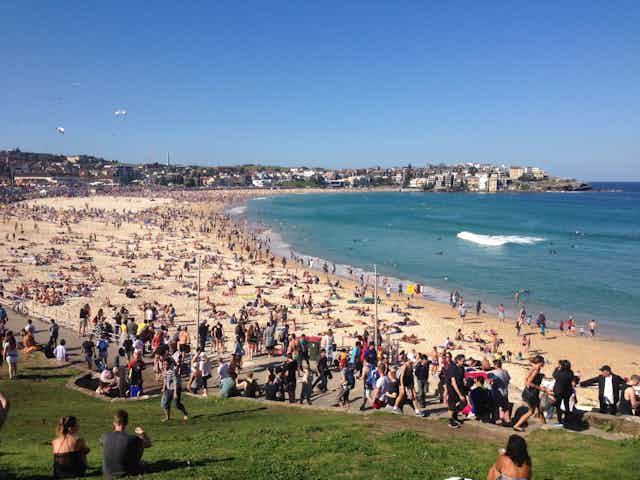Sydney is hot. Well technically, it’s persistently warm and lacking cool outbreaks, but this run of weather is no less remarkable for that.
The city has had a record 31 straight days above 26°C (and counting), smashing the previous record of 19 days in a row set in 2014. Nights have also been unusually warm, with only two nights in February dropping below 19°C (equalling the record set in 2003 and 1983).
Only one day last month dipped below the average February maximum temperature for Sydney (25.8°C). The previous record for February was five below-average days, which happened in 2000, 1983 and 1978.
March has continued this pattern, with every day so far (including the forecast period) expected to be above average.
So what’s going on here? Is it climate change? Is it the super El Niño? Is it urban heating, or some other factor? Or is it just natural variation in the weather?
Like many things in life, the answer is that it’s complicated.
Weather report
Over recent weeks, there have been extended periods with a high-pressure ridge over eastern New South Wales and weak low-pressure troughs inland. That is creating mostly stable atmospheric conditions for Sydney (that is, no rain) and funnelling warm air from central Australia over the metropolitan region.
In addition, the Southern Annular Mode (SAM), the oscillating latitude of prevailing westerly winds, has been positive for most of February. This results in high-pressure systems sitting further to the south, blocking the passage of cold fronts across New South Wales.
But while it’s not the first time we’ve seen this combination of weather factors, it’s the first time it has resulted in such a persistently warm February.
Of course, February is warm anyway: Sydney’s second-warmest month of the year, only 0.1°C behind January on average. And, with apologies for stating the obvious, summer is our warmest season and therefore the one when high temperature records are most likely to fall.
A key question to ask is: if the February average is 25.8°C and we’re talking about a run of days above 26°C, is this really that exceptional?
Well, perhaps not in terms of news headlines, although we’ve all noticed the summer warmth spilling into autumn. But what is most notable is the total lack of intervening cool conditions.
It’s not just a case of picking one number that works either. Sydney has set a record for the longest run of days above 24°C, 25°C, 26°C and 27°C for any month. Sydney’s February 2016 average maximum temperature was 28.2°C, its equal-fifth-warmest February on record.
The oceans around us
Beyond the regional weather conditions, the strong El Niño conditions have also influenced the persistent warmth. A “strong” El Niño – a description that refers to the distribution of heat in the tropical Pacific – doesn’t necessarily equate to a correspondingly strong impact on our weather.
That said, El Niños tend to result in more hot days and heatwaves for eastern Australian locations like Sydney.
Offshore sea temperatures have also been uncharacteristically warm. The East Australian Current has extended further south (incidentally causing havoc with the oyster industry), bringing warm waters to the southeast coast and also contributing to Tasmania’s hottest summer on record.

If we don’t consider Sydney’s recent weather in isolation, then it is clear that climate change is playing its role here as well. Both land and ocean temperatures have warmed. And those warmer offshore sea surface temperatures keep our nights warmer, particularly in coastal cities.
Warm, hot conditions are becoming more likely, while cool outbreaks are becoming less so. The whole of southeastern Australia has experienced fewer cold outbreaks in recent years (although they do still happen).
Highs and lows
Sydney in January had warm temperatures, with two heatwaves (defined as at least three 30°C days in a row), but interspersed with quite a few wet spells. One of them, caused by an East Coast Low, resulted in the coldest January day since 1978 – a maximum of just 18.6°C on January 6, 2016.
Sydneysiders probably remember this as that one weird day when we all wore jumpers and Ugg boots.
The persistent warmth has the effect of making these cool changes more noticeable and memorable. But the ongoing high temperatures are actually the more unusual aspect of our weather, which is why hot records are being broken far more regularly than cold ones.
It’s not just February and March. It may be but a distant memory now, but Sydney has already had four heatwaves (three straight days of at least 30°C) this warm season (October 4-6; November 18-20; January 11-14; and January 19-21) – another record.
According to our climate outlook, March is shaping up to be warm for both daily maximum and nightly minimum temperatures. The record warm run could extend to 37 days, with possibly another heatwave thrown into the mix. It’s lucky that Sydney has lots of beaches.
All statistics in this article are based on records from Sydney Observatory Hill, which run from 1858 to the present.

